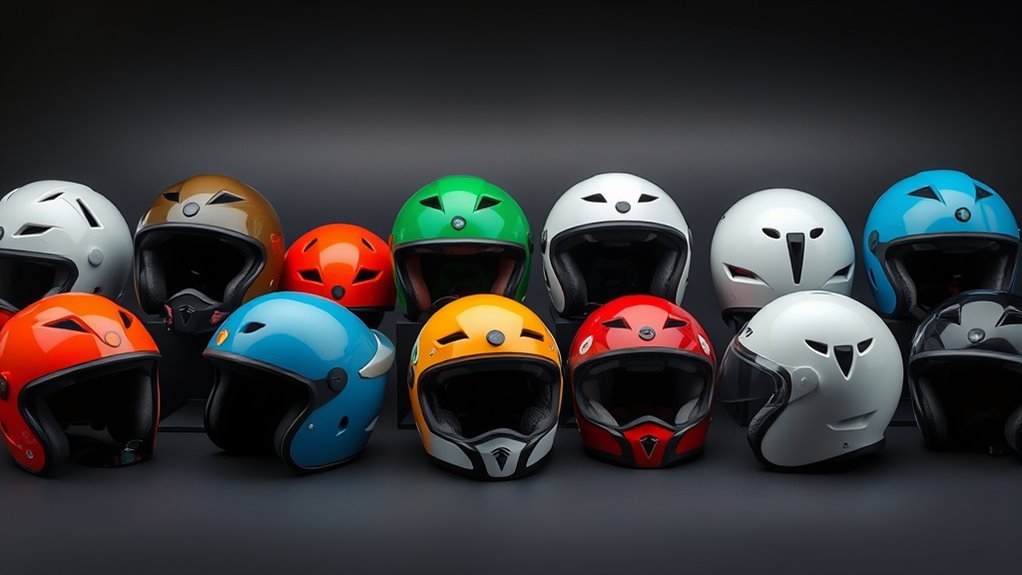Helmet Regulations Around the World: A Guide
Helmet regulations differ greatly worldwide, shaped by cultural attitudes toward safety and personal freedom. In North America, laws vary by state, with Canada enforcing stricter mandates. Europe showcases a mix from strict French laws to optional helmets in the Netherlands. Asia sees disparities in enforcement, while Australia and New Zealand focus on compliance and injury reduction. Understanding these differences is essential for evaluating safety outcomes. If you’re curious, there’s much more to explore on this topic.
Global Overview of Helmet Laws

As you navigate the world of helmet regulations, it is essential to recognize that laws vary considerably across countries and regions. In some places, strict laws mandate helmet use for all riders, reflecting a robust helmet culture and a high level of safety awareness. In contrast, other regions may adopt a more lenient approach, allowing personal choice over mandatory compliance. This divergence often stems from cultural attitudes toward risk and responsibility. While some countries prioritize individual freedom, they also face challenges in promoting safety. Understanding these differences helps you appreciate the broader context of helmet regulations and their implications for public health. Ultimately, balancing personal freedom with safety awareness remains a complex but significant discussion within the global helmet landscape.
North America: Helmet Regulations in the USA and Canada

While helmet regulations in North America vary between the USA and Canada, both countries exhibit distinct approaches to rider safety. In the USA, helmet laws differ considerably by state; some mandate helmet use for all riders, while others allow exemptions for certain age groups or experience levels. This fragmentation reflects a broader safety culture that often prioritizes personal freedom over standardized regulations. Conversely, Canada generally enforces stricter helmet laws, requiring helmet use for all riders. This unified approach underscores a commitment to safety that resonates throughout the country. Ultimately, understanding these regulations can enhance your riding experience while ensuring you navigate the legal landscape effectively, balancing personal choice with the importance of safety in your riding endeavors.
Europe: Helmet Use Across Different Countries

Helmet regulations in Europe present a varied landscape that reflects each country’s unique approach to motorcycle and bicycle safety. In the Netherlands, for instance, a strong helmet culture exists among cyclists, but it’s not mandatory, allowing for personal choice. Conversely, countries like France enforce strict helmet laws for both cyclists and motorcyclists, promoting safety through regulation. You’ll notice that cycling trends influence these regulations; as biking becomes more popular in urban areas, some nations are reconsidering their approaches. In the UK, helmets aren’t legally required, yet many riders choose to wear them, illustrating a balance between freedom and safety. Overall, Europe showcases a spectrum of regulations, emphasizing diverse attitudes towards helmet use and individual responsibility.
Asia: Diverse Approaches to Helmet Safety
When examining helmet safety regulations across Asia, it becomes clear that there’s a significant disparity in enforcement and cultural attitudes. Countries vary widely in their approach, influenced by economic factors and urban infrastructure. Here are three key aspects to evaluate:
- Cultural attitudes: In some regions, wearing helmets is often viewed as optional, reflecting a casual approach to safety.
- Enforcement strategies: Countries like Vietnam have strict penalties for non-compliance, while others lack consistent enforcement, undermining traffic regulations.
- Public awareness: Safety campaigns and education programs are critical in shaping demographic differences in helmet use, with varying success across nations.
Australia and New Zealand: Stricter Helmet Mandates
In Australia and New Zealand, helmet regulations are particularly strict, focusing on compliance with established safety standards. You’ll find that enforcement and penalties for non-compliance can be quite significant, aimed at ensuring public safety. Analyzing these measures reveals their potential impact on reducing injuries and fatalities among cyclists.
Helmet Standards Compliance
As the importance of safety gear becomes increasingly recognized, Australia and New Zealand have implemented stricter helmet mandates to enhance compliance with established standards. This guarantees that riders not only wear helmets but also use those that meet rigorous safety benchmarks. Here are key elements of helmet standards compliance:
- Helmet Testing: Each helmet must undergo thorough testing to assess its performance in impact resistance and durability.
- Compliance Certification: Only helmets that pass these tests receive certification, allowing consumers to identify safe options easily.
- Quality Assurance: Regular inspections of manufacturing processes guarantee that helmets maintain consistent quality over time.
Enforcement and Penalties
While compliance with helmet standards is vital for rider safety, the enforcement of these regulations in Australia and New Zealand has become increasingly stringent. You may find that penalty disparities exist between regions, with some areas imposing hefty fines for non-compliance. This variation can create confusion among riders seeking to understand their obligations. Enforcement effectiveness is a key focus for authorities, as they aim to guarantee that helmet use becomes a norm rather than an exception. However, some argue that excessive penalties could infringe on personal freedoms. Striking a balance between safety and individual choice is essential, and as regulations continue to evolve, you’ll want to stay informed about the implications of these stringent enforcement measures.
Impact on Safety
Stricter helmet mandates in Australia and New Zealand have led to a marked increase in rider safety, evidenced by a decline in head injuries among motorcyclists and cyclists. The focus on helmet effectiveness and safety awareness is vital in these regions, as data shows significant benefits.
- A 30% reduction in head injuries reported among cyclists since the implementation of stricter laws.
- Enhanced helmet designs that meet stringent safety standards, improving overall protection.
- Increased public awareness campaigns encouraging responsible riding practices and helmet use.
These measures not only foster a culture of safety but also empower riders to enjoy their freedom while minimizing risks. Clearly, the impact of these regulations enhances both safety and the quality of riding experiences in Australia and New Zealand.
South America: Varying Levels of Enforcement
Helmet regulations across South America showcase a patchwork of enforcement that can vary considerably from one country to another. In countries like Argentina and Chile, strict laws exist, but cultural attitudes often lead to lax enforcement. Many riders prioritize personal freedom over compliance, viewing helmets as optional rather than essential. Conversely, in nations like Brazil, economic factors play a significant role; while laws may be in place, limited resources hinder enforcement efforts, allowing non-compliance to persist. This disparity reflects broader societal values, where the balance between individual freedom and safety is continually negotiated. As you navigate these diverse landscapes, understanding local attitudes towards helmet use will greatly influence your experience and perspective on road safety.
Africa: Helmet Laws and Their Impact on Safety
In Africa, helmet laws vary considerably from one country to another, impacting rider safety differently across the continent. You’ll find that injury statistics often reflect these disparities, highlighting the correlation between regulation and accident outcomes. However, enforcement challenges persist, complicating efforts to improve compliance and reduce injuries.
Country-Specific Regulations
While many African countries have enacted helmet laws aimed at improving road safety, the effectiveness of these regulations varies greatly across the continent. Factors such as cultural attitudes and helmet design innovations substantially influence compliance and safety outcomes.
- South Africa: Strict laws exist, but enforcement is inconsistent, leading to mixed results in safety.
- Kenya: Helmet use is legally mandated, yet many riders resist due to cultural beliefs regarding freedom and identity.
- Nigeria: Helmet laws are in place, but the market lacks affordable, quality helmet design innovations, hindering widespread adoption.
Understanding these country-specific regulations helps you appreciate the complex interplay of legislation, culture, and safety technology in Africa.
Injury Statistics Analysis
The impact of helmet laws on injury statistics across Africa reveals significant disparities in rider safety outcomes. Countries with strict helmet regulations generally report lower injury rates, highlighting the critical role of injury prevention. A statistical analysis shows that compliance with helmet laws correlates with reduced fatalities and severe injuries among motorcyclists.
| Country | Helmet Law Status | Injury Rate (per 100,000) |
|---|---|---|
| South Africa | Strict | 12 |
| Nigeria | Moderate | 25 |
| Kenya | Lax | 40 |
These figures demonstrate how legislative measures can influence rider safety. As you evaluate helmet laws, consider how these statistics reflect the effectiveness of regulations in promoting safer riding environments across the continent.
Enforcement Challenges Faced
Although helmet laws are established to enhance rider safety, enforcing these regulations across Africa presents substantial challenges. You might find that enforcement difficulties and compliance issues stem from several key factors:
- Limited Resources: Many law enforcement agencies lack the manpower and tools to effectively monitor helmet use.
- Cultural Attitudes: In some regions, there’s a prevailing belief that helmets are unnecessary, making it hard to change mindsets.
- Economic Constraints: Riders often prioritize immediate financial needs over purchasing helmets, leading to widespread non-compliance.
These factors contribute to a cycle where helmet laws exist in theory but fail to translate into real-world safety improvements. For effective regulation, it’s essential to address these challenges while respecting individual freedoms.
Exceptions and Exemptions: Who Is Exempt From Helmet Use?
Who might find themselves exempt from helmet use? In various regions, exemptions often apply to specific groups based on cultural attitudes toward personal freedom and risk. For instance, some jurisdictions allow adult cyclists to ride without helmets if they meet certain criteria, reflecting a belief in individual choice over mandated safety. Additionally, exemptions may extend to those participating in traditional or cultural events, where wearing helmets might clash with local customs. Safety advocacy groups sometimes support these exemptions, arguing that education and personal responsibility can be more effective than blanket regulations. Ultimately, the landscape of helmet regulations varies widely, shaped by the balance between safety considerations and the desire for personal autonomy.
The Future of Helmet Regulations: Trends and Changes Ahead
As helmet regulations evolve, various factors are influencing potential changes in the coming years. Future innovations in helmet technology, along with increased public awareness and advocacy efforts, are reshaping how we view safety. Here are three trends to reflect on:
- Smart Helmets: Integrating technology like sensors and communication systems could enhance safety and user experience.
- Increased Advocacy: Organizations pushing for mandatory helmet laws may push communities to rethink regulations based on safety data.
- Personalization: Customizable helmets that fit individual needs might emerge, balancing style with safety.
These developments can lead to more informed choices, promoting not just safety but also the freedom to ride while feeling secure. Embracing these changes might redefine helmet regulations globally.
Frequently Asked Questions
Are There Age Restrictions for Helmet Use in Different Countries?
Yes, there are age restrictions for helmet use in various countries. Most places mandate helmets for children and young adults, often under 18, while some regions have no specific age requirements. Additionally, helmet exemptions exist, particularly for certain activities or in specific areas. You’ll find that these regulations aim to balance safety with personal freedom, reflecting differing cultural attitudes toward risk and responsibility when it comes to riding bicycles or motorcycles.
What Materials Are Recommended for Safe Helmet Construction?
For safe helmet construction, you’ll want materials that prioritize foam padding and impact resistance. Expanded polystyrene (EPS) foam is commonly used due to its excellent shock-absorbing properties. Look for helmets with a tough outer shell, often made from polycarbonate or fiberglass, which enhances durability. The combination of these materials guarantees that the helmet can effectively manage impacts, giving you the protection you need while maintaining your freedom to ride confidently.
How Do I Choose the Right Helmet Size?
To choose the right helmet size, start by measuring your head circumference just above your eyebrows. Use a flexible tape measure and note the size in centimeters or inches. Once you have your size measurement, consult the manufacturer’s sizing chart, as sizes can vary. When trying on a helmet, make certain it fits snugly without being uncomfortable; it shouldn’t move when you shake your head. A proper helmet fitting is key for your safety and freedom while riding.
Can Wearing a Helmet Actually Cause Injuries?
Yes, wearing a helmet can cause injuries if it doesn’t fit properly or isn’t designed for your activity. Poor helmet safety can lead to neck strain or discomfort during use. However, the primary purpose of a helmet is injury prevention; when worn correctly, it greatly reduces the risk of head injuries in accidents. Always verify your helmet meets safety standards and fits snugly to maximize protection while enjoying your freedom on the road or trail.
What Are the Penalties for Not Wearing a Helmet?
Not wearing a helmet can land you in hot water. Penalties vary widely, but you could face fines, points on your license, or even community service. Helmet enforcement is strict in many areas, and the legal consequences can add up quickly. While some may argue it infringes on personal freedom, the regulations aim to protect you from serious injury. Ultimately, the choice to wear a helmet might save you from more than just a fine.






